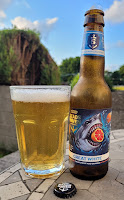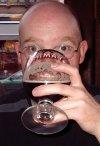 I'm not unfamiliar with Dutch beer and brewing, but had never heard of Rotterdam's Stadshaven Brouwerij, until I found six of its beers in the Mace off licence on Dublin's South Circular Road. They're in retro 33cl longnecks and keenly priced at €3 a pop. All aboard!
I'm not unfamiliar with Dutch beer and brewing, but had never heard of Rotterdam's Stadshaven Brouwerij, until I found six of its beers in the Mace off licence on Dublin's South Circular Road. They're in retro 33cl longnecks and keenly priced at €3 a pop. All aboard!Sailors' Lager is first out. How do we know it's for sailors? There's lemon in it. There's a haze too, the pale amber body being lightly translucent. Zesty lemonade presents in the aroma, suggesting this is going to be a bit of a novelty beer. If only there'd been some clue on the label. It's quite heavy, though only 4.9% ABV: the spec suggests refreshment is the goal, but it's a bit of a chewer. The lemon element is sweet and almost sickly, finishing on an artificial and slightly plasticky twang. This has its charms, I guess, but it's neither subtle nor balanced. An industrial-grade pilsner has been given a squirt of fruit essence and we're supposed to be impressed. I wasn't feeling it.
 Let's see if they do any better with witbier. The visuals of Great White weren't, er, great: a lager-clear pale yellow. The aroma has me back in Belgium, with a sizeable whack of unctuous melon and apricot, with overtones of pink peppercorn and clove. This is why we like Belgian-style beer. It's rather thin in the mouth, and the lack of haze leads to a lack of softness; there's none of the fluff that ought to be part of the witbier spec. The addition of grapefruit is what distinguishes this from your standard witbier but I couldn't detect where that went. The citrus side in general is sweet and syrupy, implying that any citrus that featured did so as a gloopy extract. We're a little too far away from the classic dry and spicy, yet soft, witbier specification for this to count as a good one. It's sticky, sharp and, above all, artificial and contrived. This is a long way from the vision of Pierre Celis, and for me, that's a problem.
Let's see if they do any better with witbier. The visuals of Great White weren't, er, great: a lager-clear pale yellow. The aroma has me back in Belgium, with a sizeable whack of unctuous melon and apricot, with overtones of pink peppercorn and clove. This is why we like Belgian-style beer. It's rather thin in the mouth, and the lack of haze leads to a lack of softness; there's none of the fluff that ought to be part of the witbier spec. The addition of grapefruit is what distinguishes this from your standard witbier but I couldn't detect where that went. The citrus side in general is sweet and syrupy, implying that any citrus that featured did so as a gloopy extract. We're a little too far away from the classic dry and spicy, yet soft, witbier specification for this to count as a good one. It's sticky, sharp and, above all, artificial and contrived. This is a long way from the vision of Pierre Celis, and for me, that's a problem. Continuing by ABV, the 5.5% IPA sits near the middle of the set, which is unusual. As is the use of tangerine and star anise in Moray IPA. It's a dense and murky carrot colour in the glass, with lots of foam and quite an artificial aroma, wearing the additives gaudily, and the spicy star anise in particular. Unsurprisingly, there's a lot of sweetness here: the big crystal malt toffee of old-school American IPA plus a syrupy fruit element which suggests that no real tangerine has been near it. A tannic dryness that's almost equally as strong as the sugar pleasingly cuts off any potential sickliness before it starts. It's still a heavy beer, though: I got through it slowly and it was getting unpleasantly warm before I finished. Overall, I don't think it quite works. The novelty ingredients take away from its IPA qualities -- and it's certainly not "hoppy" as proclaimed on the label -- but they don't add anything positive. You could badge this as a dubbel and I doubt anyone would blink, which is a fatal flaw for any IPA.
Continuing by ABV, the 5.5% IPA sits near the middle of the set, which is unusual. As is the use of tangerine and star anise in Moray IPA. It's a dense and murky carrot colour in the glass, with lots of foam and quite an artificial aroma, wearing the additives gaudily, and the spicy star anise in particular. Unsurprisingly, there's a lot of sweetness here: the big crystal malt toffee of old-school American IPA plus a syrupy fruit element which suggests that no real tangerine has been near it. A tannic dryness that's almost equally as strong as the sugar pleasingly cuts off any potential sickliness before it starts. It's still a heavy beer, though: I got through it slowly and it was getting unpleasantly warm before I finished. Overall, I don't think it quite works. The novelty ingredients take away from its IPA qualities -- and it's certainly not "hoppy" as proclaimed on the label -- but they don't add anything positive. You could badge this as a dubbel and I doubt anyone would blink, which is a fatal flaw for any IPA. With startling originality, the red ale is called Redhead. This time la fée purée has blessed us with lime and lychee. It looks well: a deep mahogany red and refreshingly clear. Bracing for calorific sugar vapours, I was happy to find that it doesn't actually smell of much: the caramel malt that it looks like, more of those assertive tannins, and a friendly wisp of metallic English hops. There's still no fruit gunk in the flavour. Tannins and toffee are nearly the whole of it, with a mildly drier roast crisping the edges. It's a pretty good take on red ale as it is practised in Ireland, albeit at a significantly higher strength at 5.8% ABV. Anyone looking for that bite of lime or sumptuous lychee squish will be disappointed, and they should buck up their ideas about beer, quite frankly. This is solid, unfussy, ungimmicky, and grown-up, even if its label isn't.
With startling originality, the red ale is called Redhead. This time la fée purée has blessed us with lime and lychee. It looks well: a deep mahogany red and refreshingly clear. Bracing for calorific sugar vapours, I was happy to find that it doesn't actually smell of much: the caramel malt that it looks like, more of those assertive tannins, and a friendly wisp of metallic English hops. There's still no fruit gunk in the flavour. Tannins and toffee are nearly the whole of it, with a mildly drier roast crisping the edges. It's a pretty good take on red ale as it is practised in Ireland, albeit at a significantly higher strength at 5.8% ABV. Anyone looking for that bite of lime or sumptuous lychee squish will be disappointed, and they should buck up their ideas about beer, quite frankly. This is solid, unfussy, ungimmicky, and grown-up, even if its label isn't. A blond ale, in the broadly Belgian category, comes next in sequence: Octopus. Again, they've decided it needs fruit extract, and again you can't taste it. Orange and kiwi are the wastes of everyone's time on this occasion. There's maybe a tiny kick of zest lurking in the background, but for the most part this is another simple, classically constructed, to-style job. There's an enjoyably gooey honey centre, infused with bubblegum and pear esters, and then balanced with a crisp cereal crunch around the edges. At 6% ABV and quite heavy-feeling, it's not a sessioner, but one 33cl serving felt just right. Other than four-packs of UK-brewed Leffe, we don't get much beer in this style in these parts, so this one is welcome, even if it's probably quite yawn-worthy in its homeland.
A blond ale, in the broadly Belgian category, comes next in sequence: Octopus. Again, they've decided it needs fruit extract, and again you can't taste it. Orange and kiwi are the wastes of everyone's time on this occasion. There's maybe a tiny kick of zest lurking in the background, but for the most part this is another simple, classically constructed, to-style job. There's an enjoyably gooey honey centre, infused with bubblegum and pear esters, and then balanced with a crisp cereal crunch around the edges. At 6% ABV and quite heavy-feeling, it's not a sessioner, but one 33cl serving felt just right. Other than four-packs of UK-brewed Leffe, we don't get much beer in this style in these parts, so this one is welcome, even if it's probably quite yawn-worthy in its homeland. The final Dutchman in our flotilla is a tripel called Pirhana. Mango and kumquat. Let's not even bother. There's a worrying lack of head on this. Maybe it's my fault for putting it into a Westmalle glass, which that tripel always fills out nicely with a luxurious marshmallow of foam. The derisory skim of schuim here is downright ugly. No shade on the bright and clear golden body beneath, however. Though 8.5% ABV, it's a good deal thinner than the blonde ale which preceded it, and that's given it a flavour which is much less impactful, complex, and enjoyable. There's plenty of hot alcohol, but not much by way of fruit and spice. Only the dry tannic finish does what good tripel does; otherwise it's a poor show, doing the bare minimum to pass. If that's what €3 gets you in this space, then perhaps fair enough. On its merits, though, this is basic stuff: less a piranha and more of a damp squid.
The final Dutchman in our flotilla is a tripel called Pirhana. Mango and kumquat. Let's not even bother. There's a worrying lack of head on this. Maybe it's my fault for putting it into a Westmalle glass, which that tripel always fills out nicely with a luxurious marshmallow of foam. The derisory skim of schuim here is downright ugly. No shade on the bright and clear golden body beneath, however. Though 8.5% ABV, it's a good deal thinner than the blonde ale which preceded it, and that's given it a flavour which is much less impactful, complex, and enjoyable. There's plenty of hot alcohol, but not much by way of fruit and spice. Only the dry tannic finish does what good tripel does; otherwise it's a poor show, doing the bare minimum to pass. If that's what €3 gets you in this space, then perhaps fair enough. On its merits, though, this is basic stuff: less a piranha and more of a damp squid.My report card for Stadshaven says "must try harder". A sampler pack of fruit syrup does not make for a vibrant range of modern beers, for one thing. I sense an ability to do plain-spoken beers quite well, testified by the red and blonde in particular. Whether the decision not to steer that course is a creative one or a management one, I cannot say. The low price point is very much in these beers' favour, though I'm still not sure I got my money's worth from them.





No comments:
Post a Comment